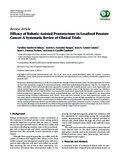Efficacy of robotic-assisted prostatectomy in localized prostate cancer : a systematic review of clinical trials

Ver / Descargar
Fecha
2013-11-10Autor(es)
Sandoval Salinas, CarolinaGonzález Rangel, Andrés L.
Cataño Cataño, Juan Guillermo
Fuentes Pachón, Juan C.
Castillo Londoño, Juan S.
Autor(es) Corporativo(s)
Pontificia Universidad Javeriana. Facultad de Medicina. Departamento de Cirugía y Especialidades. Grupo de Investigación de Cirugía y Especialidades
Pontificia Universidad Javeriana. Facultad de Medicina. Departamento de Cirugía y Especialidades. Urología
Tipo
Artículo de revista
ISSN
1687-6369 / 1687-6377 (Electrónico)
Páginas
1-7
Tipo de artículo
Artículo de revisión
Compartir este registro
Citación
Documentos PDF
Abstract
Background. Radical prostatectomy is an effective treatment for clinically localized prostate cancer. The three approaches in current use have been extensively compared in observational studies, which have methodological limitations. Objective. To compare the efficacy and safety of three radical prostatectomy approaches in patients with localized prostate cancer: open, laparoscopic, and robotic-assisted laparoscopic surgery. Materials and Methods. A systematic review of the literature was carried out. Databases MEDLINE, EMBASE, LILACS, and CENTRAL were searched for randomized clinical trials that directly compared two or more radical prostatectomy approaches. Selection criteria, methodological rigor, and risk of bias were evaluated by two independent researchers using Cochrane Collaboration’s tools. Results. Three trials were included. In one study, laparoscopic surgery was associated with fewer blood loss and transfusion rates than the open procedure, in spite of longer operating time. The other two trials compared laparoscopic and robotic-assisted surgery in which no differences in perioperative outcomes were detected. Nevertheless, robotic-assisted prostatectomy showed more favorable erectile function and urinary continence recovery. Conclusion. At the present time, no clear advantage can be attributed to any of the existing prostatectomy approaches in terms of oncologic outcomes. However, some differences in patient-related outcomes favor the newer methods. Larger trials are required.
Enlace al recurso
https://www.hindawi.com/journals/au/2013/105651/Fuente
Advances in Urology; (2013)
Estadísticas Google Analytics

